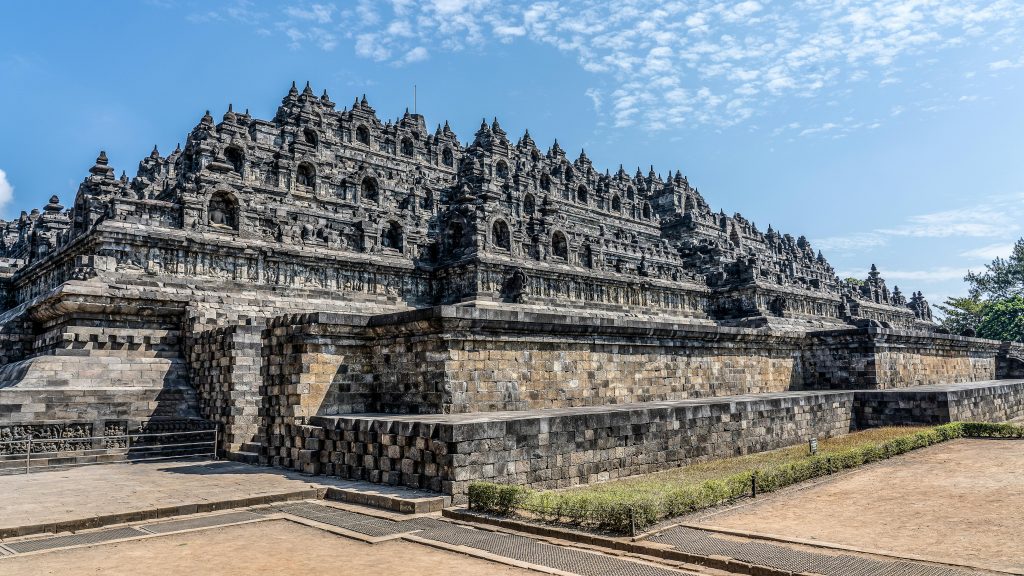Bali Travel Guide #1: An Introduction to Bali for Slow Explorers
Dreaming of Bali, but yearning for more than just a fleeting glance? This Bali Travel Guide for Slow Travel invites you to experience the Island of the Gods not as a tourist, but as a mindful explorer. Discover how to truly connect with Bali’s vibrant culture, serene landscapes, and spiritual heart, allowing its magic to unfold at a pace that nourishes your soul.
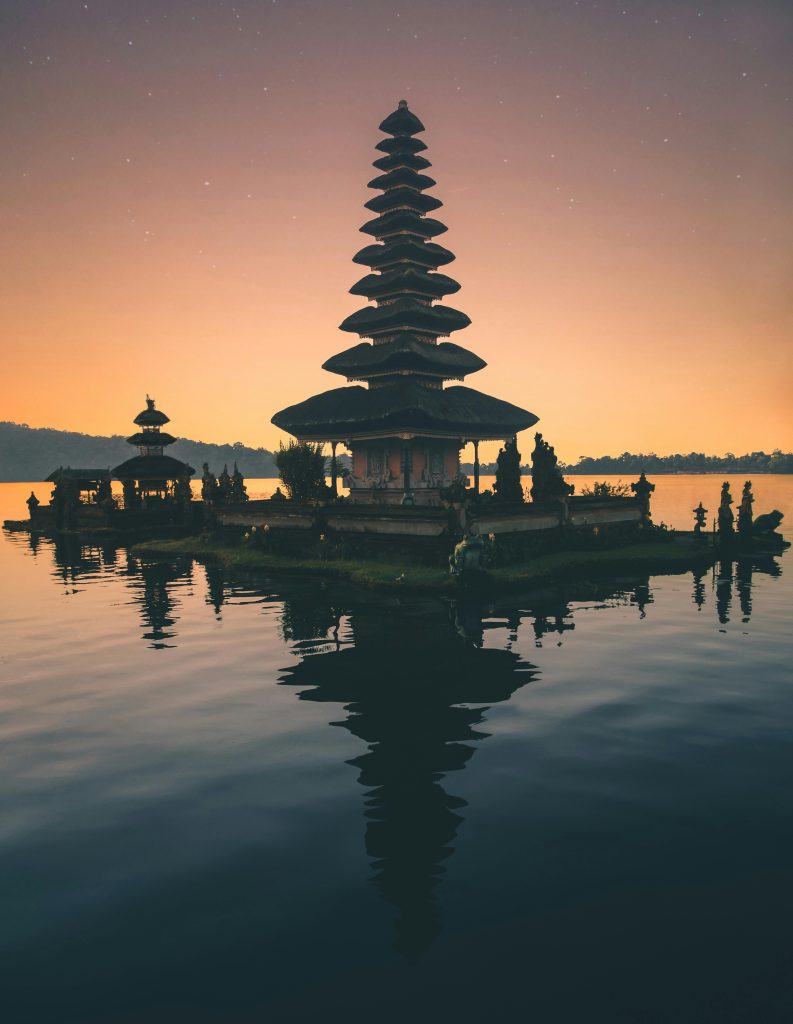
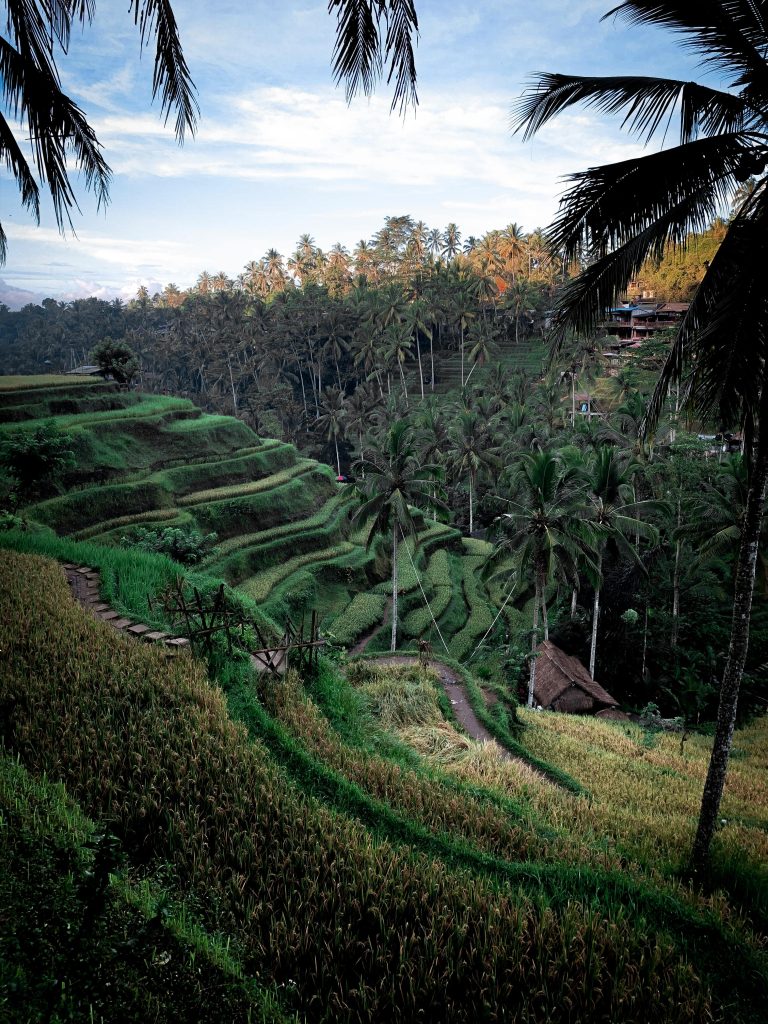
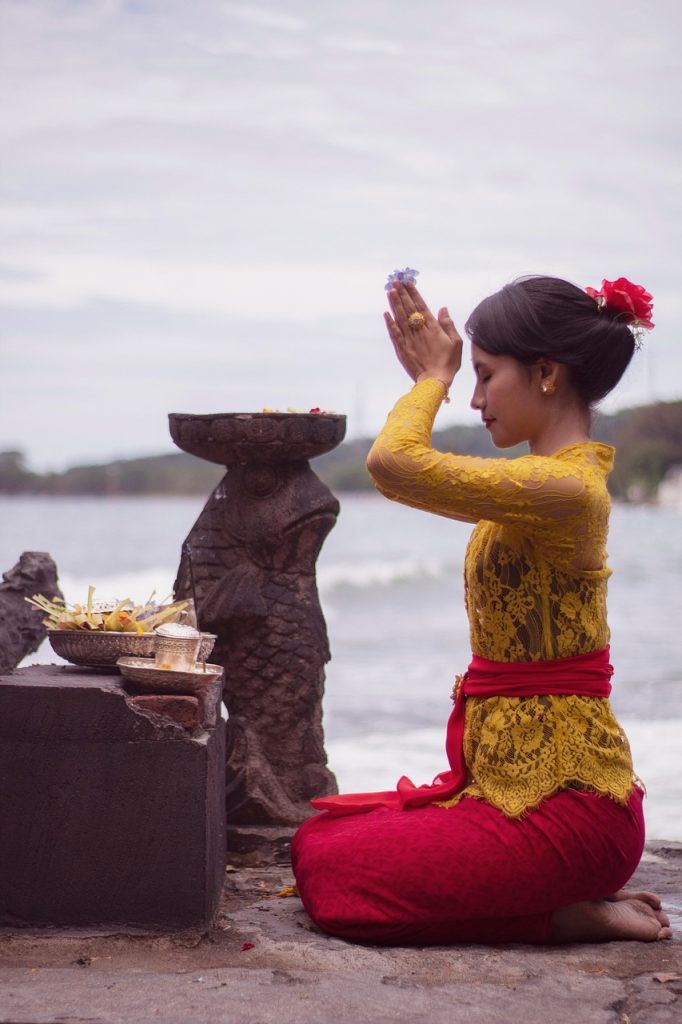
Bali has always felt like a gift.
A place that rewards those who pause. The island invites reflection, deeper breathing, and gentle discovery. Its rhythm reveals itself in the small things: the quiet glow of a dawn over rice fields, the murmur of water from a hidden temple spring, or the cadence of gamelan music drifting through the air at night.
Many visitors rush from beach to temple to mountain in just a few days. Yet it is when one lingers — sitting with a cup of ginger tea in a family-run café, or watching the same rice field shift colors from morning green to dusk gold — that Bali begins to open its heart.
Slow travel is not about how much ground you cover, but how deeply you connect.
Where to Stay for a Slower Journey
For those seeking a base, the central highlands offer a natural rhythm. Ubud and Mengwi, set amid rice terraces and traditional villages, allow travelers to explore much of the island while staying rooted in its cultural heart.
Accommodations here often embrace simplicity: bamboo cottages surrounded by palms, family guesthouses where breakfast arrives with a smile, eco-lodges that blend into the landscape. Choosing where to stay becomes more than convenience — it becomes part of the journey itself.
For longer stays, we recommend rent a cottage or small house—Airbnb is our go-to, and monthly discounts are common. Waking up to birdsong and the rustle of rice stalks feels far more grounding than any hotel alarm.
But sometimes, you take short trips to other parts of the island—maybe a beach weekend or a few days in the mountains—before returning to ‘homebase’, where you would always feel most at home.
We have also discovered many wonderful accommodations around Bali that truly align with the spirit of slow travel. These are places that either integrate design beautifully with the natural surroundings, offer mindful services like yoga, massage, or cooking classes, or support local communities through sustainability programs or cultural exchange. They’re more than just places to sleep—they’re spaces to pause, reflect, and reconnect. Please read here how to Find the Best Deals on Bali Rental Villas 2025
Getting Around: The Motorbike Way
Bali’s roads can be chaotic, especially in the south. If you want flexibility, renting a motorbike in Bali is by far the best way to explore.
There are plenty of rental agents who’ll deliver the bike right to your door. All you need is your passport—easy, breezy. The prices are very reasonable:
- 💰 Cost: IDR 60,000–100,000/day (cheaper for long-term rentals)
- 🛵 Where: Local agents are everywhere and can deliver the bike to your stay
- 📋 Requirements:
- Locals: Just your ID
- Foreigners: Officially need an international driver’s license (some rent without, but it may void your insurance)
Choose whatever style fits your vibe—from sporty Vario scooters to more retro models. Just make sure they document the condition beforehand so there are no surprises later. And ride safe—repairs can be costly, but fair.
💡Motorbike Safety & Essentials
- Always wear a helmet (it’s the law—and your lifesaver).
- Bring your international driver’s license.
- Don’t forget sunscreen and a poncho—it’s Bali!
What Each Corner Offers
While we’re all for slow travel—the kind where you soak in the atmosphere, not just tick boxes—we know how helpful a little overview can be when planning a trip. So consider this your Bali-at-a-glance guide: a quick regional breakdown to give you a feel for the island’s different vibes, landscapes, and experiences. Not a checklist to rush through, but a compass to help you explore with intention.
We’ve written a separate post that explores Bali in all its corners—the slow travel way. Read the full guide here.
South Bali – Buzzing, Beachy, and Bold
The island’s most energetic corner—where waves, nightlife, and luxury meet.
- Popular spots:
- Seminyak: Chic beach clubs (like Potato Head and KU DE TA), boutique shopping, trendy cafes.
- Canggu: A hipster haven with surf beaches, coworking spaces, street art, and digital nomad energy.
- Uluwatu: Dramatic sea cliffs, luxury resorts, and iconic surf breaks like Padang Padang and Bingin.
- Jimbaran: Sunset seafood dinners on the beach.
- Nusa Dua: Gated luxury, family-friendly resorts, and calm beaches.
- Top Picks:
- Catch a Kecak dance at Uluwatu Temple at sunset.
- Take a surf lesson or ride the waves.
- Dance the night away in beach clubs or rooftop bars.
Central Bali – Spiritual, Cultural, and Green
The soulful heart of Bali, where jungle temples and creative energy bloom.
- Main hub:
- Ubud: Known for its temples, yoga, traditional crafts, and deep Balinese culture.
- Landmarks and activities:
- Tegallalang Rice Terraces – iconic photo spot.
- Sacred Monkey Forest Sanctuary – playful macaques in a mystical forest.
- Goa Gajah (Elephant Cave) and Tirta Empul – ancient temples and holy springs.
- Visit the Puri Saren Royal Palace and stroll through the Ubud Art Market.
- Join a batik or silver-making workshop, or attend a healing retreat.
- Hike Campuhan Ridge Walk at sunrise.
This is the part of Bali that makes many travelers stay longer than planned. It’s also a great base for day trips to temples and volcanoes.
East Bali – Sacred, Majestic, and Peaceful
Less visited but rich in tradition and natural beauty, the east is perfect for those seeking serenity and spiritual connection.
- Top highlights:
- Mount Agung: Bali’s highest and most sacred volcano.
- Tirta Gangga: A water palace with stepping stones and koi-filled ponds.
- Lempuyang Temple: Known for the “Gate of Heaven” view (arrive early!).
- Sidemen Valley: Tranquil countryside with terraced rice fields and traditional weaving.
- Amed & Tulamben: Laid-back fishing villages, excellent for snorkeling and diving, including a sunken WWII shipwreck.
- Things to see and do:
- Visit ancient temples tucked in the mountains.
- Take a sunrise trek to Mount Batur (just northwest of this area).
- Explore Balinese daily life in local homestays or eco-villages.
North Bali – Quiet, Cool, and Natural
This area has a slower rhythm, with cooler weather, untouched villages, and hidden treasures.
- Base towns:
- Lovina: Known for black-sand beaches and dolphin-watching tours.
- Munduk: A mountain village surrounded by waterfalls, clove plantations, and misty hills.
- Top experiences:
- Chase waterfalls like Sekumpul, Gitgit, and Banyumala Twin Waterfalls.
- Soak in Banjar hot springs or visit Brahmavihara-Arama, a peaceful Buddhist monastery.
- Visit Lake Beratan and the floating Ulun Danu Temple near Bedugul.
- Explore local farms or try Bali’s best coffee from the highlands.
West Bali – Remote, Rugged, and Wild
Often skipped by tourists, West Bali is where you’ll find untamed nature and raw beauty.
- Must-sees:
- West Bali National Park: Home to Bali’s last wild forests, endangered Bali Starling birds, and mangroves.
- Menjangan Island: Part of the park—famous for crystal-clear snorkeling and vibrant coral reefs.
- Activities:
- Go snorkeling or diving in some of the best waters in Indonesia.
- Take a boat ride through the mangroves.
- Stay in eco-lodges and explore off-grid trails and traditional fishing villages.
Everyday Offerings & Spiritual Life

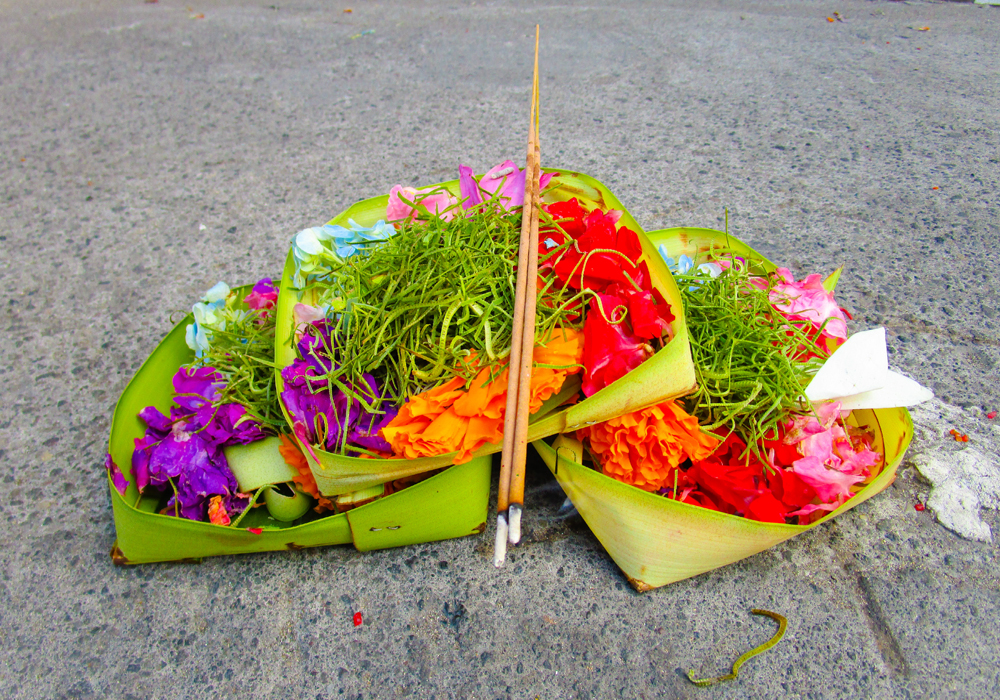
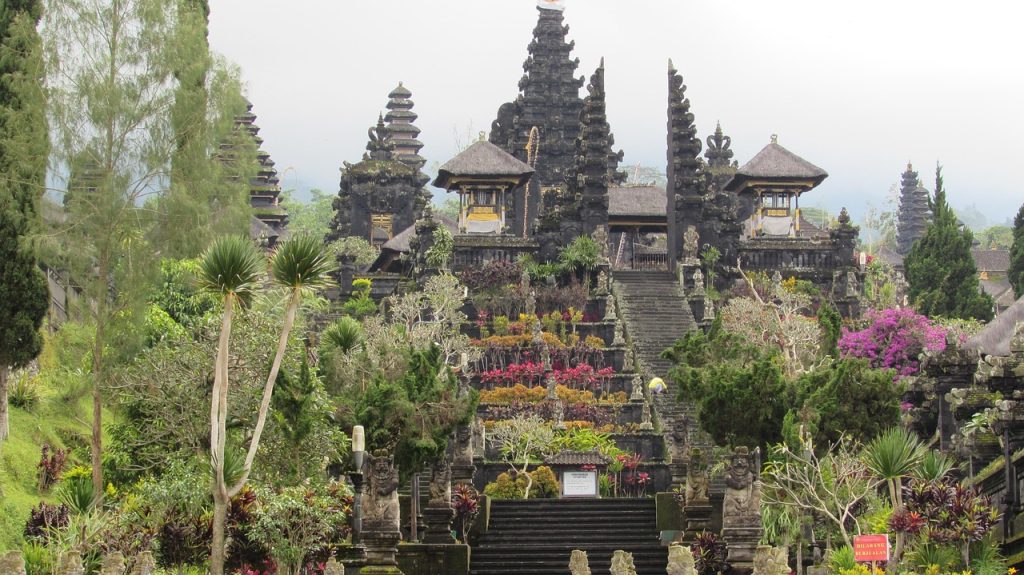
In Bali, spirituality isn’t confined to temples—it’s woven into daily life.
Wherever you go, you’ll see little palm-leaf baskets filled with flowers, rice, and incense. These offerings (canang sari) are made multiple times a day—placed on shrines, doorways, motorbikes, or even the street. Each one is a quiet prayer, a gesture of balance between the seen and unseen.
Temples are everywhere—there are over 20,000 across the island. Even in private homes, you’ll find a family shrine in the northeast corner, carefully tended with daily offerings. Each village also has three main temples (pura puseh, pura desa, and pura dalem), and ceremonies take place regularly—Odalan (temple anniversaries), Galungan and Kuningan (victory of dharma), and Nyepi (the Day of Silence) are just a few examples.
At the heart of it all stands Pura Besakih, the Mother Temple of Bali. Perched 1,000 meters high on the sacred slopes of Mount Agung, Bali’s tallest and most venerated volcano, Besakih is the island’s holiest temple complex and a powerful spiritual axis.
When praying, the Balinese wear traditional outfits: sarong, sash, kebaya. The colors, the grace, the floral scents—it’s incredibly beautiful, and deeply felt.
Slow Days and Simple Joys
Sometimes, you don’t need an itinerary. Some of the most powerful days are the unplanned ones.
💡Slow Travel Tips:
- Take a rice field walk—especially near Ubud
- Join a yoga or meditation class—casual or immersive
- Treat yourself to a Balinese massage
- Wander into a local art gallery or weaving studio
- Watch a Kecak dance at Pura Dalem or Uluwatu Temple at sunset
- Linger in a café with a good book, just listening to the rain or gamelan in the distance
Traditional Performances
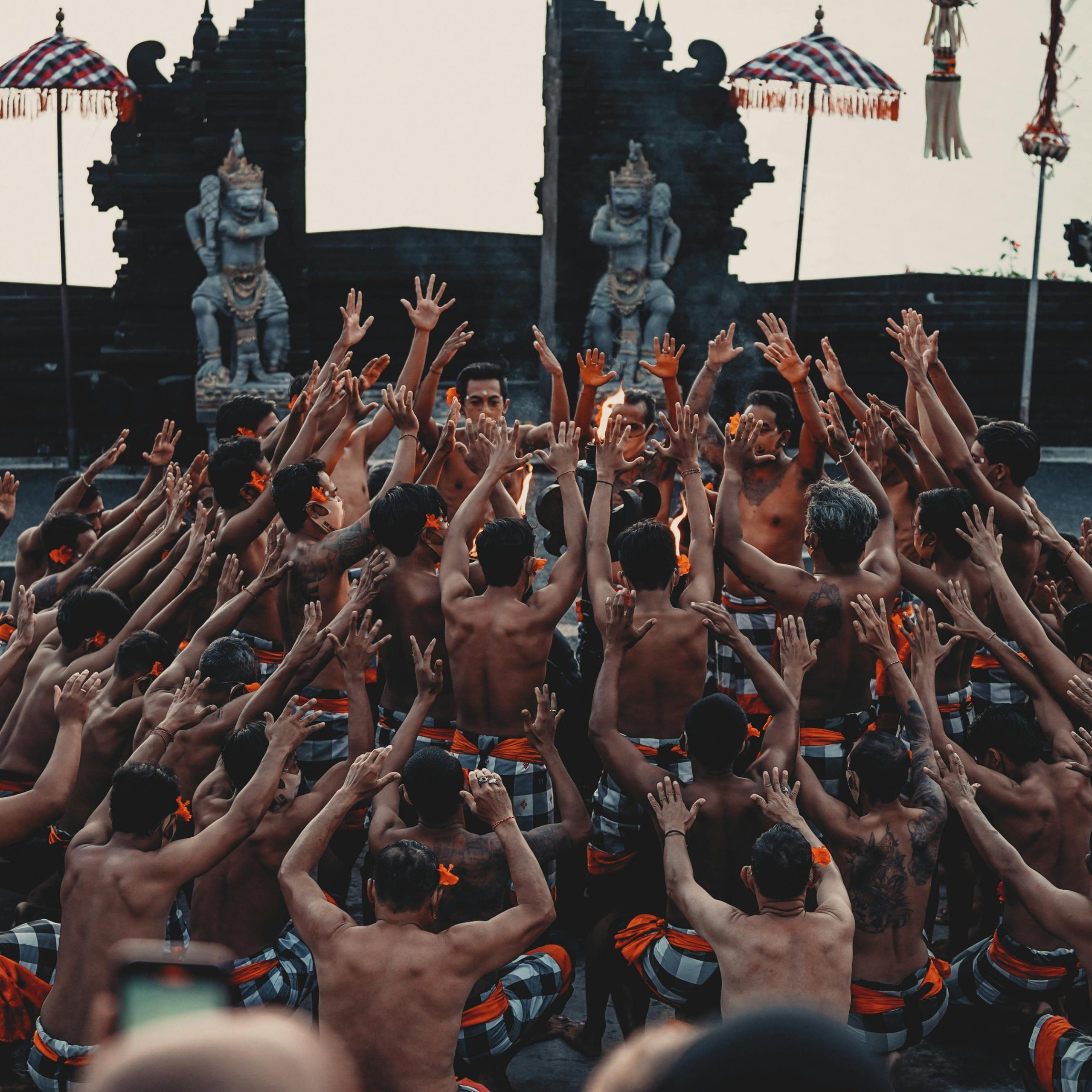
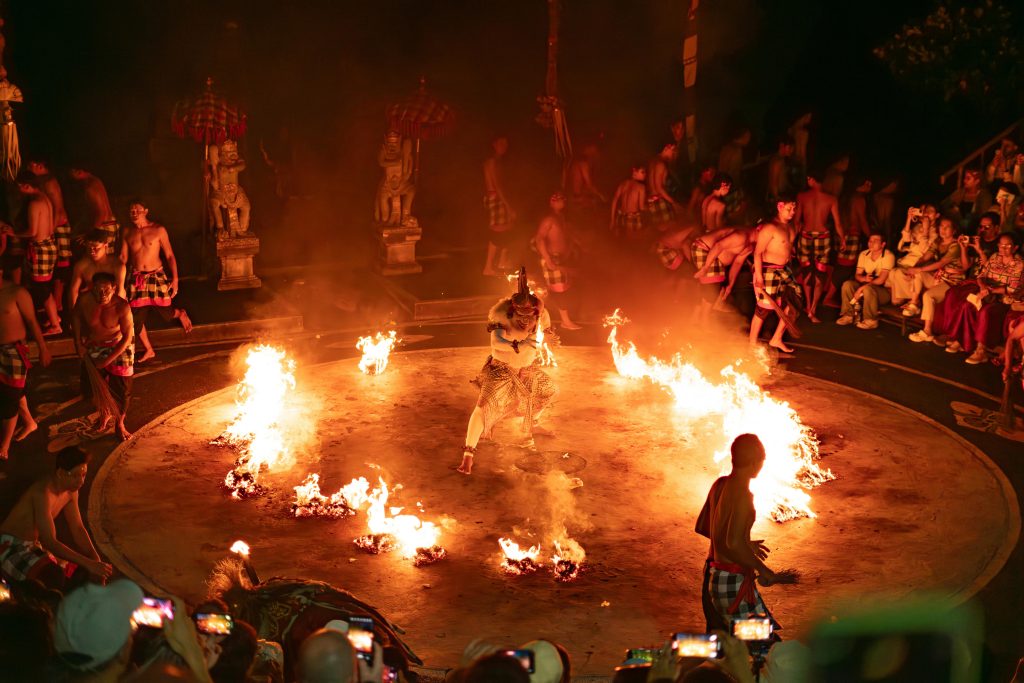
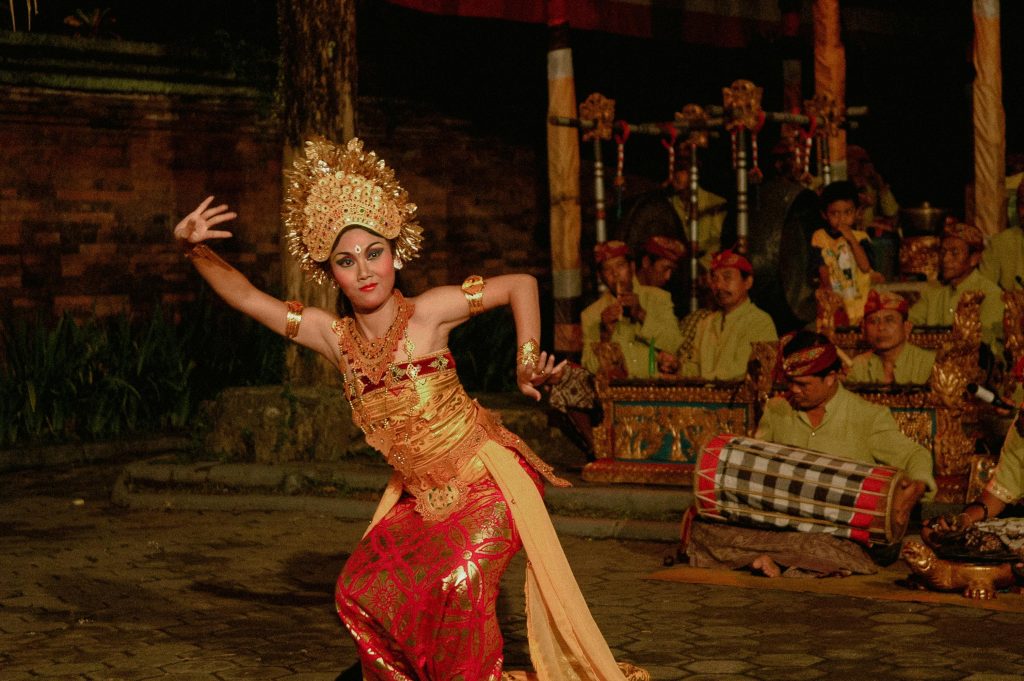
No visit is complete without seeing a Kecak dance—a powerful and hypnotic performance that blends storytelling, music, and movement in a way unlike anything else.
What makes Kecak unique? There are no musical instruments. Instead, a chorus of dozens of bare-chested men sit in concentric circles, rhythmically chanting “cak cak cak” while moving their hands in dynamic, synchronized motions. This repetitive chant creates a trance-like rhythm that sets the tone for the unfolding drama.
The story being told usually comes from the Ramayana, an ancient Hindu epic. You’ll see dramatic scenes of Prince Rama trying to rescue his wife Sita from the demon king Ravana, with appearances by the monkey god Hanuman and other mythical characters. Dancers in elaborate costumes perform in the center of the circle, moving with stylized gestures and expressions.
The chanting and synchronized movements serve not just as sound and rhythm, but as a kind of spiritual energy—meant to heighten the drama and, in traditional contexts, to help induce a trance state in both performers and audience. Kecak evolved in the 1930s from older trance rituals known as Sanghyang, in which villagers would chant to invite spirits to enter the body for healing or protection.
While modern performances are mostly theatrical, the roots of Kecak are deeply spiritual. That raw, communal energy still lingers in the air—you can feel it in your chest as the rhythm builds, and in the silence that follows.
Best places to watch include:
- Uluwatu Temple (with a cliffside sunset backdrop)
- Pura Dalem Ubud
- ARMA Museum
- Taman Saraswati Temple
Tickets range from IDR 75,000–150,000, and it’s wise to book ahead during high season.
Bali’s Art Scene: Where to See and Feel Creativity
Bali isn’t just a natural paradise—it’s a living gallery. Art is everywhere here: from temple carvings and traditional batik to contemporary paintings and installations. The island has long attracted both local and international artists, and the result is a wonderfully eclectic art scene. I’ve written a complete art travel guide for art lovers in Bali—read it here.
Ubud: The Cultural Heart
- ARMA (Agung Rai Museum of Art): A beautiful space set in lush gardens, showcasing both traditional Balinese and modern Indonesian art. Offers workshops and dance performances too.
- Neka Art Museum: A well-curated collection tracing the evolution of Balinese painting styles, including works by foreign artists who lived on the island.
- Blanco Renaissance Museum: The flamboyant former home of Spanish artist Antonio Blanco, filled with romantic, surreal paintings.
- Threads of Life: A fair-trade textile gallery that supports traditional weaving communities across Indonesia. The pieces here are museum-quality, and the stories behind them are just as rich.
Elsewhere on the Island
- Taman Budaya (Denpasar): A cultural center and venue for exhibitions, theater, and art festivals.
- Gaya Art Space (Sayan, near Ubud): A contemporary gallery promoting emerging artists.
- Biasa ArtSpace (Seminyak): Sleek, modern, and international in flavor.
- Nyaman Gallery (Seminyak): Features a mix of street art, sculpture, and fine art from local and global creatives.
Many of these places also host temporary exhibits, workshops, or artist talks. It’s worth checking out what’s on while you’re there—you might discover something unforgettable.
Taste of Bali: What to Eat

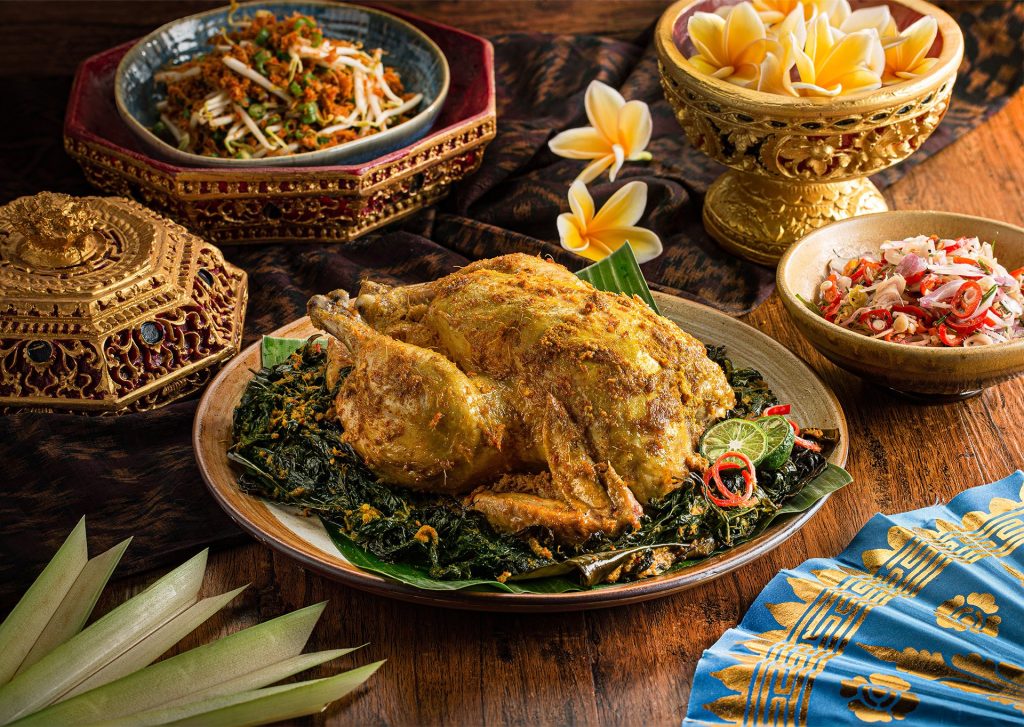

Bali’s food is a feast of flavors—earthy, spicy, fragrant, and deeply tied to tradition. Many dishes are rooted in ceremonial life, often prepared communally and passed down through generations.
Babi Guling (Suckling Pig)
Once a dish reserved for temple ceremonies and special events, Babi Guling is now widely enjoyed, especially in local warungs (small eateries). A whole pig is stuffed with a rich blend of spices—including turmeric, coriander, lemongrass, garlic, and galangal—then slow-roasted over an open fireuntil the skin turns golden and crispy. The meat inside remains juicy, infused with the spice paste, and is often served with lawar, rice, and a spicy sambal. It’s a dish of celebration, deeply tied to communal feasting and offerings.
Ayam Betutu (Spiced Steamed or Roasted Chicken)
Ayam Betutu is a ceremonial dish with royal roots, believed to have originated from Gianyar or Gilimanuk. A whole chicken (or duck) is rubbed and stuffed with “base genep,” a complex spice paste made of shallots, garlic, ginger, turmeric, galangal, chili, candle nuts, and more. The bird is then wrapped in banana leaves and slow-cooked or steamed for hours, allowing the flavors to fully absorb. The result is incredibly tender meat, falling off the bone, with deep, warming spice layers. Traditionally, it’s a centerpiece at family gatherings or temple ceremonies.
Lawar (Spiced Minced Meat, Veggies, and Coconut)
Lawar is more than a dish—it’s a cultural experience. Made by finely chopping meat (commonly pork or chicken), green beans or young jackfruit, freshly grated coconut, and mixing it all with Balinese spice paste and sometimes even fresh pig’s blood for authenticity (though not always). It’s prepared in large batches, usually by men, as part of communal cooking during ceremonies. Lawar is earthy, rich, and spicy—best eaten fresh, as it doesn’t keep long. It’s often served as a side to babi guling or steamed rice.
Sate Lilit (Minced Meat Skewers)
A uniquely Balinese take on satay, Sate Lilit uses minced meat or fish (often tuna, chicken, or pork) blended with grated coconut, lime leaves, galangal, lemongrass, and rich spices. The mixture is then molded around flat bamboo sticks or lemongrass stalks and grilled over charcoal. The result is juicy, aromatic, and smoky, with a burst of citrus and spice. Unlike the peanut-sauce satays of Java, Sate Lilit shines through its bold marinade alone—no sauce needed.
💡 Heads up: some dishes can be very spicy. If your stomach isn’t used to it, ask for tidak pedas (not spicy). And if you need a break, there are plenty of Western cafés serving everything from smoothie bowls to pizza.
💡Practical Tips for First-Time Visitors
- Best time to visit: April–October (dry season) offers sunny skies and fewer downpours.
- Avoid the crowds: Travel in the shoulder season (April, May, September), and start your day early to enjoy popular sites before tour buses arrive.
- Weather: Expect hot and humid conditions year-round. Pack light, breathable clothing—but dress modestly, especially in villages and temples.
- Health:
- Bali belly is common—stick to bottled water, and consider bringing rehydration salts or charcoal tablets just in case.
- Avoid drinking from the tap, even in hotels.
- Mosquito protection: Dengue fever is a risk, especially during the rainy season. Wear insect repellent, cover up in the evenings, and consult your doctor about the dengue vaccine before your trip.
- Cultural respect:
- Never step over or on canang sari (Balinese offerings), even if they’re on the ground or seem “in the way.”
- Dress respectfully when visiting temples. Most provide sarongs and sashes, but it’s always wise to bring your own which you can buy from local markets everywhere.
- Public displays of affection are frowned upon in sacred areas—be mindful of local customs and signs.
- If menstruating, avoid entering temples.
- Sun safety: The tropical sun is strong—always wear sunblock, even on cloudy days. A hat and reusable water bottle also help you stay protected and hydrated.
- Money Tips:
- Cash is still king in many areas. Carry small bills for markets and local eateries.
- ATMs are widely available, but use ones attached to banks to avoid skimming.
A Note From The Road ✍️
Bali is more than a destination—it’s a balm for the soul. It’s the scent of wet earth and incense, the sound of geckos at night, the sacred silence after temple bells ring.
Come here not to conquer your checklist, but to let go of it. Let the island carry you gently— some through heartbreak, others through joy, or through rediscovery.
Take your time.
Stay curious.
And let yourself be changed.

